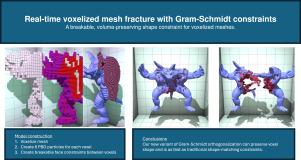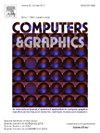具有Gram-Schmidt约束的实时体素网格断裂
IF 2.8
4区 计算机科学
Q2 COMPUTER SCIENCE, SOFTWARE ENGINEERING
引用次数: 0
摘要
以前关于可变形体断裂的研究大多集中在物理原理(如能量和质量守恒)上,导致仿真方法非常逼真,但尚未适用于实时。我们提出了一种程式化的动画方法来破坏软体,这种方法在视觉上是合理的,并且能够以每秒数百帧的速度运行,牺牲了视觉真实感和物理准确性。我们的方法使用了一种新的基于Gram-Schmidt正交规格化的体素约束,当与可破坏的面对面体素约束一起使用时,我们可以对可破坏的模型进行动画化。我们还描述了可选的LOD约束,这些约束加速了模型的收敛并增加了模型的表观刚度。这里提供的创建管道和约束旨在最小化并行高斯-赛德尔迭代所需的分区数量。我们在内存使用、计算时间和视觉结果的基础上,将所提出的技术与形状约束和最先进的物质点法进行了比较。本文章由计算机程序翻译,如有差异,请以英文原文为准。

Real-time voxelized mesh fracture with Gram–Schmidt constraints
Much previous research about fracture of deformable bodies has focused on physical principles (e.g. energy and mass conservation), leading to simulation methods that are very realistic, but not yet applicable in real-time. We present a stylized animation method for destruction of soft bodies that is visually plausible and capable of running at hundreds of frames per second by sacrificing visual realism and physical accuracy. Our method uses a new volume-preserving voxel constraint based on Gram–Schmidt orthonormalization which, when used in tandem with a breakable face-to-face voxel constraint, allows us to animate destructible models. We also describe optional LOD constraints which speed convergence and increase apparent stiffness of the models. The creation pipeline and constraints presented here are designed to minimize the number of partitions needed for parallel Gauss–Seidel iterations. We compare the proposed techniques with shape constraints and the state-of-the-art material point method on the basis of memory usage, computation time and visual results.
求助全文
通过发布文献求助,成功后即可免费获取论文全文。
去求助
来源期刊

Computers & Graphics-Uk
工程技术-计算机:软件工程
CiteScore
5.30
自引率
12.00%
发文量
173
审稿时长
38 days
期刊介绍:
Computers & Graphics is dedicated to disseminate information on research and applications of computer graphics (CG) techniques. The journal encourages articles on:
1. Research and applications of interactive computer graphics. We are particularly interested in novel interaction techniques and applications of CG to problem domains.
2. State-of-the-art papers on late-breaking, cutting-edge research on CG.
3. Information on innovative uses of graphics principles and technologies.
4. Tutorial papers on both teaching CG principles and innovative uses of CG in education.
 求助内容:
求助内容: 应助结果提醒方式:
应助结果提醒方式:


